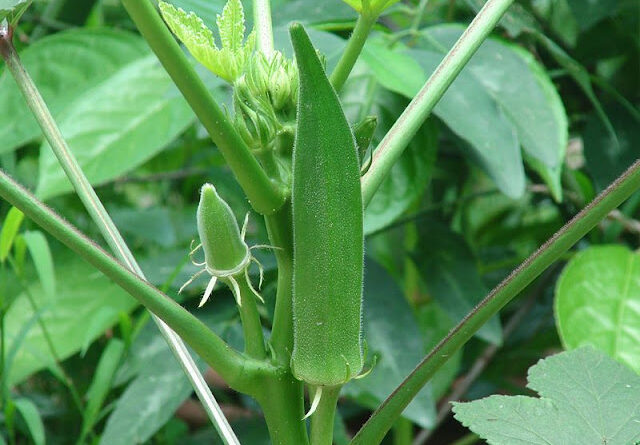Cultivation of Okra ; Abelmoschus esculentus (L) Moench.
Okara (Abelmoschus esculentus (L) Moench) is a warm-season flowering plant that belongs to the family Malvaceae.
Okra crop duration ranges 90-100 days and the ideal temperature for its growth ranges 25 to 30-degree celsius
Soil Requirement for Okra Cultivation;
Okra cultivation can be done in a wide range of soils But the Sandy loam soil rich in organic matter with an optimum pH range of 5.8 to 7 are most suitable for okra cultivation. Okra cultivation gives good yields in heavy soil with a good drainage system.
Okra Seeds and it’s cultivation;
February-March,
June- July
October-November.
Seed rate of Okra ;
7 kg/ha for Kharif sown crop.
Note; Storage of seeds Packing of okra seeds in polythene cover (700 gauge) increases the storage life up to 7 months.
Planting Method in okra cultivation ;
For the Kharif cultivation of Okra crop, sow the seeds at a spacing of 60 cm ( row to row) and 45 cm (Pant to Plant ). While for the summer crop, soak the seeds in water for 24 hours before the sowing and maintain a spacing of 60 Cms. ( Row to Row) x 30 cm. ( Plant to Plant )
Water management in Okra cultivation ;
Nutrient management in Okra cultivation ;
Give a basal dose of FYM or compost @ 12 t/ha. before the sowing, the okra crop and subsequently apply the doses of the N, P2O5, and K2O @ 25, 8 and 25 kg/ha. Another dose of 25 kg N per ha may be applied one month after sowing for better vegetative growth of the Okra crop.
Note: A fertilizer dose of N:P2O5: K2O 75:5:15 kg/ha is recommended for the reclaimed soils.
Weed management for Okra cultivation ;
Conduct weeding regularly and earth up rows during the rainy season.
Both the nymphs and the adults suck the sap from the undersurface of leaves result in the tender leaves turn yellow, leaf margins curl downwards, and reddening sets in. At the time of severe infestation, the leaves turn in to a bronze or brick red colour which gives a typical “hopper burn” appearance and ultimately result in a retarded Crop growth.
Whitefly: Bemisia tabaci (Aleyrodidae: Hemiptera)
The whitefly, Bemisia tabaci (Gennadius) biotype B (or B. argentifolii) (Hemiptera: Aleyrodidae), results in severe damage to okra plants by feeding on its sap, secreting honeydew, and transmitting virus diseases.
jassids, fruit and shoot borer, and root-knot nematode are the important pests of okra plant.
For the control of jassids, apply quinalphos, fenthion or fenitrothion as foliar sprays each at 0.05%. and to control the fruit and shoot borers pest, firstly we must remove all the drooping shoots and the damaged fruits. Apply a dose of carbaryl 0.15% at intervals of 15 to 20 days. For aphids, control applies dimethoate 0.05%.
The nematode can be controlled by applying sawdust or paddy husk @ 500 g/plant or neem leaves or Eupatorium leaves @ 250 g/plant in basins one week prior to planting and watering must be done on the daily basis. The effect of such treatment persists up to 75 days after the sowing in the summer season okra crop
For the control of root-knot nematode apply Bacillus macerans or B. circulans (1.2 x 106 cells per pit) well before sowing is highly recommended
Application of carbofuran granules at the @ 0.5 kg ai / ha or phorate @of 1 kg ai / ha at seeding followed by need-based application of foliar insecticides has been recommended for pest control only at the time of seeding.
it is a piece of advice that insecticides of plant origin may be used, as far as possible.
Disease management for Okra Cultivation ;
Yellow Vein Mosaic ;
YVM is the most common occurred disease in okra plants, which result in vein clearing and vein chlorosis of leaves. The yellow network of veins is very conspicuous and the veins and the veinlets became more thickened. Overall result in that fruits become too small and yellowish-green appearance in the colour. Whitefly (Bemisia tabaci) and leafhopper (Amrasca biguttula biguttula) are vectors of this virus. that is why the control of YVM is very important. Use YVM resistant varieties for the okra cultivation
Harvesting of Okra ;
The crop ready to harvest 50 – 60 days after sowing. As the pods of okra plants get matured very quickly, the frequent selection of pods with a maximum size of 2 ” to 3″ inch and still tender is the point that must be considered. A total number of 12-15 harvests can be made at the interval of everyone day








Pingback: Multi-layer farming Model Objective Process and Advantages - Agrovista-Farming